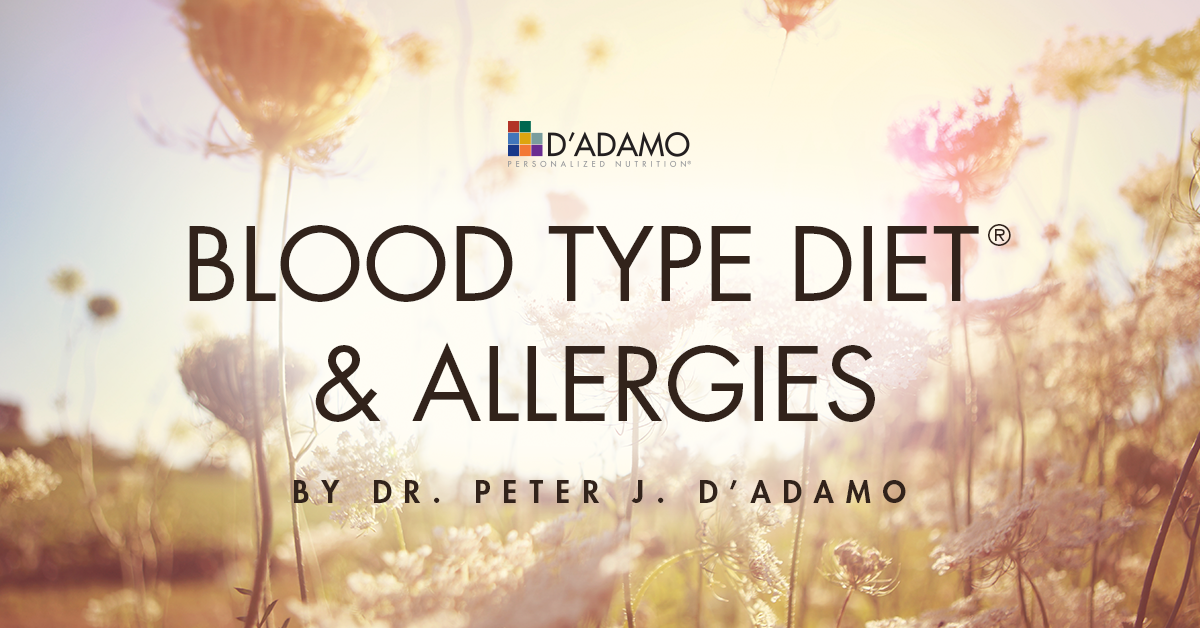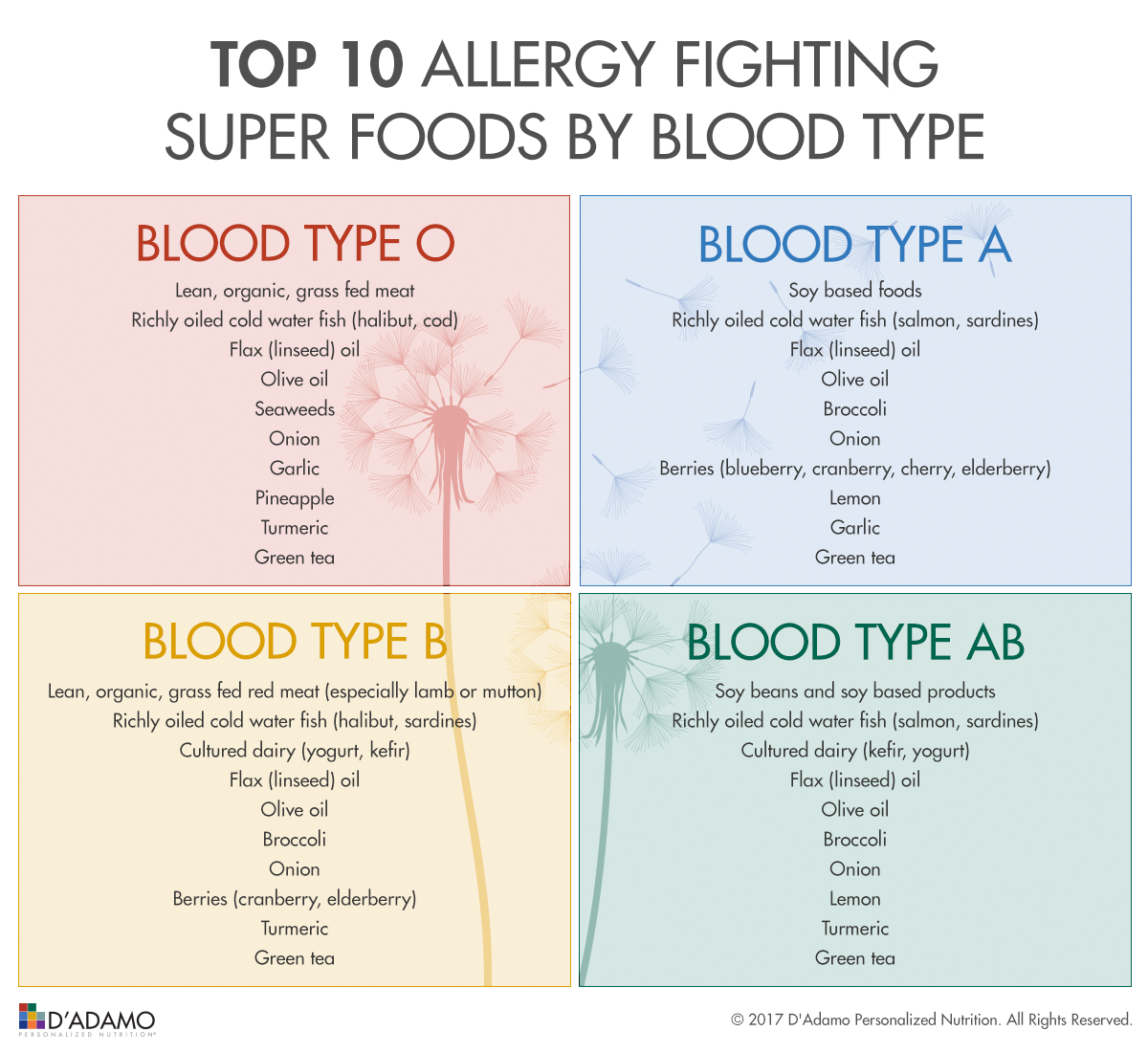Volume 14, Number 4
- Happy April by Martha D'Adamo
- Blood Type Diet and Allergies by Dr. Peter J. D'Adamo
- Top 10 Allergy Fighting Super Foods by Blood Type
- Dr. D'Adamo's Favorites for Changing Seasons
- Kathy B. - Blood Type Diet Success Story
- Blood Type Diet in the News
- Cherry Walnut Breakfast Bread - Right 4 All Blood Types
- We're on Instagram! Follow us for daily inspiration and quick healthy lifestyle tips.
Happy Aprilby Martha D'Adamo |
|
|
|
April is one of those bridge months, ever so slightly hinting at weather changes and the hidden potential of the earth revealing itself with the first bloom of the crocuses, daffodils and the brilliant yellow burst of forsythias. Along with these beautiful shifts come the less desirable aspects of April: pollen and the seasonal challenges of allergies that more and more people seem to be effected with. In this issue, we feature a wonderful article by Dr. Peter D’Adamo about allergies and the Blood Type Diet, the top ten beneficial foods for each blood type to support seasonal allergic reactions as well as some supplement support protocols to reduce the impact of seasonal allergies. As I have gotten older, my seasonal allergies have gotten more severe, and here are my four go-to suggestions as we head into the spring.
Armed with this knowledge, you should be able enjoy the spring flowers without allergies ruining the fun! Have a happy April. Martha |
|
|
|
Allergy means "altered working." Watery eyes and a runny nose are great to wash away germs when your body is fighting a virus. But when there's no actual threat to the body and it falsely sets off these countermeasures, the normally helpful symptoms serve no purpose and become disruptive. Immune cells called Immunoglobulin E (IgE for short) are created by the body in response to specific allergens. Once created, the IgE cells can last for months, immediately releasing histamine and causing symptoms whenever an offending substance is eaten or inhaled. Antihistamines suppress allergy symptoms because histamine is the chemical responsible for them. Environmental allergies can be caused by pollen, animal dander, smoke or chemicals, such as air fresheners or pollution. Pollen is the egg-shaped male reproductive cell of flowering plants. It is typically smaller than the width of a human hair and carried by the wind from one plant to another. Each species' pollen is slightly different, so it's possible to be allergic to the pollen from one specific plant but not another or to be allergic to many of them at once. Food allergies can cause hives, digestive problems, eczema and respiratory reactions. Food sensitivities or intolerances don't create IgE cells, but can still cause digestive or mood problems and can increase the body's allergic response to other substances. True food allergies usually cause symptoms within two hours, though some can happen in less than two minutes. This is why an EpiPen is carried by many with severe food allergies - in case accidental exposure to an allergen causes the throat to close rapidly. Allergies can lead to complications like sinusitis, asthma, or ear infections. Sinusitis can occur when excess mucus in the sinus cavity is not properly drained and harmful bacteria or fungi grow out of control. Ear infections can occur when the Eustachian tube is not properly drained and pathogens take root. Both of these conditions are worsened when allergies increase mucus in the nose. Extrinsic asthma, also called atopic asthma, is directly related to allergens and IgE reactions. Intrinsic asthma is caused by cold air, infections, inhaled irritants, exercise or emotional distress. Atopic asthma is more common in children, but most asthma sufferers have a combination of both types. The body's response to allergens can be mediated by reducing overall stress on the body. This is how the Blood Type Diet can help. Red blood cells have chemicals called antigens on the outer surface, which vary by blood type. Many foods contain natural chemicals called lectins, many of which interact with blood type antigens. Often times the body can handle the effects of dietary lectins or environmental allergens, but trying to deal with both simultaneously can cause symptoms. Blood type also affects how efficiently we can digest carbohydrates or red meat. "Leaky gut" is more likely to develop when eating foods we have trouble digesting, like those that contain harmful lectins for our specific blood type. This is a type of gastrointestinal (GI) damage where there are tiny holes in the walls of the digestive system, which allows larger food molecules to be absorbed. More lectins and allergens get into the bloodstream where they don’t belong, which can lead to problems. A healthy GI system will break down foods into smaller particles before they're absorbed, reducing the chance of unwanted reactions. Lectins can bind with IgE molecules and make them release histamine. A diet high in harmful lectins can also increase overall inflammation. The way blood type is directly affected by allergies is different for each type though. For Type O individuals, dietary lectins react more with IgE molecules, leading to more aggressive allergies and overall inflammation. Type A’s produce more mucus on average and more of a substance known as selectin, which leads to inflammation as well. People with Type AB blood have lower overall immunity, but some of the best resistance to respiratory based allergies. Finally, Type B’s have increased susceptibility to lung inflammation, like asthma, and viral infections. Understanding these distinctions is key to maintaining your health in the allergy-heavy season of spring! For more information, including a complete listing of foods for each blood type, you can refer to my books ALLERGIES: Fight Them with the Blood Type Diet. and The Complete Blood Type Encyclopedia, A complete listing of the foods for the Blood Type Diet can also be found on my Type Base 4 page. |
|
Seasonal allergies can be a nuisance. Following a nutrition plan tailored to your Blood Type can help to balance your immune system, reduce inflammation and make you more keenly aware of environmental and dietary factors that trigger your allergic response. Here are the top ten foods sorted by blood type that support your body to minimize the level of allergic responses. |
|
These checklists were excerpted from the |
Dr. D'Adamo's Favorites for:
|
|
|
Abundant blooms and changing foliage are among the many joys that come with the start of spring. Breathe easy and achieve optimal health by following your specific Blood Type Diet, GenoType Diet, or SWAMI Diet. Find additional seasonal support with Dr. Peter D'Adamo's unique naturopathic supplement formulas below. |
|
 |
Quercetin Plus |
 |
Collinsonia Plus |
 |
Redoxa |
 |
Breathe Easy Pack The pack includes:
|
 |
Allergies: Fight Them With The Blood Type Diet Allergies: Fight Them With The Blood Type Diet features:
Finally, Allergies includes a four-week plan for getting started that offers practical strategies for eating, exercising, and living right to prevent, fight, manage and treat the symptoms. |
Kathy B.Blood Type Diet Success Story |
|
 
My husband and I started out on Jenny Craig and Nutrisystem, two programs that provided us with meals to eat and a regimen to follow. He was an investor in both so I figured they were worth a shot. Despite eating all the unpleasant food they gave us neither option helped us substantially. Our clothes might have been slightly less snug from time to time, but I didn’t feel any better. From there we hopped from fad diet to fad diet, never truly finding the right plan for us. By 1998 the spare tire I was carrying around my waist began to truly bother me. It seemed to grow faster than ever when I decided to switch from beef to chicken, the so-called lower calorie healthy meat of the time. I soon became unable to wear my own wedding rings and lost flexibility in my wrists as well. In July of the same year, I heard about the Blood Type Diet and approached it with the healthy skepticism I had developed from my negative experiences with other programs. But despite my doubts, I jumped into the Eat Right 4 Your Type book with eagerness and hope. I found out that I was a Type B non-secretor and followed the guidelines for that type immediately. After two weeks of strictly following the diet, I lost a whopping five inches off the spare tire that had been plaguing me. I was hooked on the wonderful feeling and was thrilled to share it with my husband. But before I had the opportunity, he was pronounced dead on the eighteenth hole of a golf course during the middle of a match. He was resuscitated in the ambulance and had to be constantly worked on at the hospital by a slew of doctors when he arrived. After six bypasses, the addition of a defibrillator and forty days in the hospital, he finally regained some semblance of health. During his trials I stayed by his side, constantly reading the Eat Right 4 Your Type book in the meantime. I studied every detail and continued to follow the diet during his struggle for survival. Despite the stress of the situation, I had energy and felt healthy because of the diet. When we got home after the forty-day struggle, I put my ailing husband on the Blood Type Diet as well. Since he was Type A, I made sure to only give him the foods that were best for him and the changes in his overall wellness that followed were outstanding. The first check-in with the doctors evoked the same shock from each one who saw him. They said unanimously, “I cannot believe how good these tests look.” Though my husband only lived for 5 more years after the incident, each and every moment after his collapse on the course was a gift. The Blood Type Diet not only prolonged his time on this Earth but added so much to his quality of life as well. He was able to play golf again, travel all over the world with me, and enjoy himself because of it. My journey with the Blood Type Diet still hasn’t stopped. I continue to explore the depths of my own body’s chemistry by exploring the genotyping that Dr. Peter D’Adamo suggests for people who strive for an even more personalized look at their health. I’ve been passing the knowledge to everyone around me as well. While selling vitamins for a corporation in 1999, myself and the people working there ran experiments that tested some of the “Avoid” and “Beneficial” foods for each type. While on beneficial, everyone lost weight. After three weeks of eating only avoid foods the people who participated gained significant weight and felt horribly sluggish. These moments proved to me beyond the shadow of a doubt that you can truly harm your body by eating the wrong foods. At this point of my life, I am healthy, vibrant and happy. My family, including my grandchildren and even my great-grandson all follow the diet to a “T” and all share the same vitality. I can’t thank Dr. D’Adamo enough for all he has done for me personally and those around me. I will continue to share the benefits of this program so even more people can see the startlingly positive results I have. |
|
|
|
|
|
Cherry Walnut Breakfast Bread INGREDIENTS:
DIRECTIONS:
|
Cherry Walnut Breakfast Bread INGREDIENTS:
DIRECTIONS:
|
|
For both recipes, it’s best to eat the bread toasted with a generous layer of nut butter or jam. Just be sure to pick a topping Right 4 Your Type *If you are a non-secretor, adjust the recipes as needed. |
|







